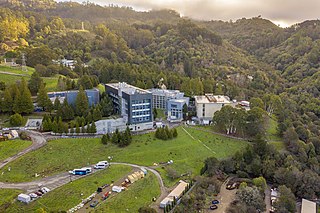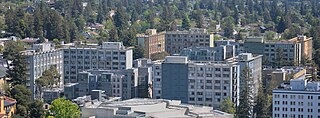
The University of California, Berkeley is a public land-grant research university in Berkeley, California. Established in 1868 as the University of California, it is the state's first land-grant university and the founding campus of the University of California system. Its fourteen colleges and schools offer over 350 degree programs and enroll some 32,000 undergraduate and 13,000 graduate students. In 2022, Berkeley ranked among the world's top universities.

Lawrence Berkeley National Laboratory (LBNL) is a federally funded research and development center in the hills of Berkeley, California, United States. Originally established in 1931 by the University of California (UC), the laboratory is now sponsored by the United States Department of Energy and administrated by the UC system. Ernest Lawrence, who won the Nobel prize for inventing the cyclotron, founded the Lab and served as its Director until his death in 1958. Located in the hills of Berkeley, California, the lab overlooks the campus of the University of California, Berkeley.

The UC Berkeley College of Chemistry is one of the fourteen schools and colleges at the University of California, Berkeley. It houses the department of chemistry and the department of chemical and biomolecular engineering, both of which are ranked among the best in the world. Its faculty and alumni have won 18 Nobel Prizes, 9 Wolf Prizes, and 11 National Medals of Science.
The Walter A. Haas School of Business, also known as Berkeley Haas, is the business school of the University of California, Berkeley, a public research university in Berkeley, California. It was the first business school at a public university in the United States and is ranked among the best business schools in the world by The Economist, Financial Times, QS World University Rankings, U.S. News & World Report, and Bloomberg Businessweek.

The University of California, Berkeley College of Engineering, branded as Berkeley Engineering, is the engineering school of the University of California, Berkeley, a public research university in Berkeley, California.

The University of California, Berkeley School of Education, or the Berkeley School of Education (BSE), is one of fourteen schools and colleges at the University of California, Berkeley, a public research university in Berkeley, California. Historically ranked as one of the top schools of education in the United States, the BSE specializes in teacher training and education research.

Evans Hall is the statistics, economics, and mathematics building on the campus of the University of California, Berkeley.

Housing at the University of California, Berkeley, includes student housing facilities run by the office of Residential and Student Service Programs (RSSP). Housing is also offered by off-campus entities such as fraternities and sororities and the Berkeley Student Cooperative (BSC).
The campus of the University of California, Berkeley, and its surrounding community are home to a number of notable buildings by early 20th-century campus architect John Galen Howard, his peer Bernard Maybeck, and their colleague Julia Morgan. Subsequent tenures as supervising architect held by George W. Kelham and Arthur Brown, Jr. saw the addition of several buildings in neoclassical and other revival styles, while the building boom after World War II introduced modernist buildings by architects such as Vernon DeMars, Joseph Esherick, John Carl Warnecke, Gardner Dailey, Anshen & Allen, and Skidmore, Owings and Merrill. Recent decades have seen additions including the postmodernist Haas School of Business by Charles Willard Moore, Soda Hall by Edward Larrabee Barnes, and the East Asian Library by Tod Williams Billie Tsien Architects.
The Engineering Campus is the colloquial name for the portions of campus surrounding the Bardeen Quadrangle and the Beckman Quadrangle at the College of Engineering at the University of Illinois at Urbana–Champaign. It is an area of approximately 30 square blocks, roughly bounded by Green Street on the south, Wright Street on the west, University Avenue on the north, and Gregory Street on the east.

Michael L. Benedum Hall of Engineering is a landmark academic building on the campus of the University of Pittsburgh in Pittsburgh, Pennsylvania, United States. The building was designed in the brutalist style by the architectural firm of Deeter, Ritchey, and Sippel and completed in 1971 at a cost of $15 million. The building was honored with both the Pennsylvania Society American Institute of Architects Honor Award and Distinguished Building Award. It was built with a gift from the Claude Worthington Benedum Foundation and funds from the General State Authority. It stands on a 1.8-acre (7,300 m2) site that was formerly occupied by the National Guard's Logan Armory.
The College of Engineering and Applied Science is the engineering and applied science college of the University of Cincinnati in Cincinnati, Ohio. It is the birthplace of the cooperative education (co-op) program and still holds the largest public mandatory cooperative education program at a public university in the United States. Today, it has a student population of around 4,898 undergraduate and 1,305 graduate students and is recognized annually as one of the top 100 engineering colleges in the US, ranking 83rd in 2020.

A hackerspace is a community-operated, often "not for profit", workspace where people with common interests, such as computers, machining, technology, science, digital art, or electronic art, can meet, socialize, and collaborate. Hackerspaces are comparable to other community-operated spaces with similar aims and mechanisms such as Fab Lab, men's sheds, and commercial "for-profit" companies.

The California Institute for Telecommunications and Information Technology (Calit2, previously Cal(IT)2), also referred to as the Qualcomm Institute (QI) at its San Diego branch, is a $400 million academic research institution jointly run by the University of California San Diego (UCSD) and the University of California, Irvine (UCI); in January 2022, plans were announced to add University of California, Riverside to the consortium. Calit2 was established in 2000 as one of the four UC Gray Davis Institutes for Science and Innovation. As a multidisciplinary research institution, it is conducting research discovering new ways in which emerging technologies can improve the state's economy and citizens' quality of life. Keeping in mind its goal of addressing large-scale societal issues, Calit2 extends beyond education and research by also focusing on the development and deployment of prototype infrastructure for testing new solutions in real-world environments. Calit2 also provides an academic research environment in which students can work alongside industry professionals to take part in conducting research and prototyping and testing new technologies.

The California Institute for Quantitative Biosciences (QB3) is a nonprofit research and technology commercialization institute affiliated with three University of California campuses in the San Francisco Bay Area: Berkeley, San Francisco, and Santa Cruz. QB3's domain is the quantitative biosciences: areas of biology in which advances are chiefly made by scientists applying techniques from physics, chemistry, engineering, and computer science.
The Irwin and Joan Jacobs School of Engineering is an undergraduate and graduate-level engineering school offering BS, BA, MEng, MS, MAS and PhD degrees at the University of California, San Diego in San Diego, California. The Jacobs School of Engineering is the youngest engineering school of the nation's top ten, the largest by enrollment in the University of California system, as well as the largest engineering school on the West Coast and the ninth-largest in the country. More than thirty faculty have been named members of the National Academies. The current dean of the Jacobs School of Engineering is Albert P. Pisano. The Jacobs School of Engineering sends a monthly news email which anyone can subscribe to.

CMR Institute of Technology (CMRIT) is a private engineering college located in Bengaluru, India. CMRIT is a technical and management institution affiliated to Visvesvaraya Technological University and approved by All India Council for Technical Education (AICTE), New Delhi. CMRIT is recognized by Government of Karnataka.

The College of Engineering is a college within the University of Notre Dame. The Dean of the College of Engineering is Patricia J. Culligan, Ph.D. Its graduate school for Engineering is ranked #47 in the USA and #15 for undergraduate.

The Syracuse University College of Engineering and Computer Science is one of the 13 schools and colleges of Syracuse University. The College offers more than 30 programs in four departments – Biomedical and Chemical Engineering; Civil and Environmental Engineering; Electrical Engineering and Computer Science; and Mechanical and Aerospace Engineering and The College.















